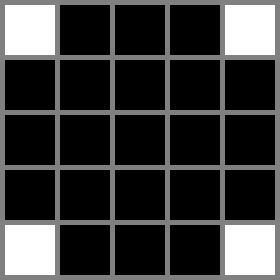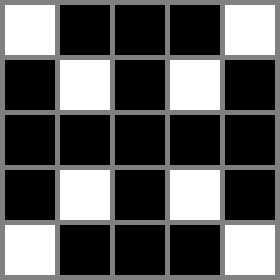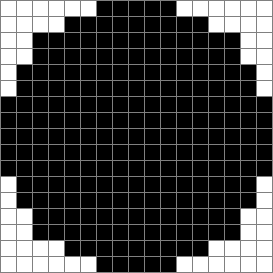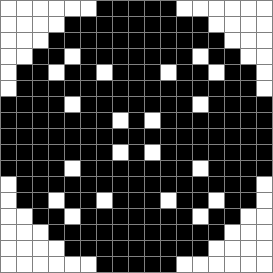Google Code Jam '22 Round 2 Problem B - Pixelated Circle
View as PDFTypical computer images are matrices of pixels, with each pixel being a small square of a specific color. Drawing lines that are not perfectly parallel to the axes of the pixel matrix results in imperfections. Drawing circles is an extreme example where those imperfections arise.
Suppose we have a picture consisting of set_pixel_to_black(x, y) makes the pixel at row
draw_circle_perimeter(R):
for x between -R and R, inclusive {
y = round(sqrt(R * R - x * x)) # round to nearest integer, breaking ties towards zero
set_pixel_to_black(x, y)
set_pixel_to_black(x, -y)
set_pixel_to_black(y, x)
set_pixel_to_black(-y, x)
}Notice that some pixels may be set to black more than once by the code, but the operation is idempotent (that is, calling set_pixel_to_black on a pixel that is already black changes nothing).
The following is pseudocode for a function to draw a filled circle (starting from an all-white picture).
draw_circle_filled(R):
for x between -R and R, inclusive {
for y between -R and R, inclusive {
if round(sqrt(x * x + y * y)) <= R:
set_pixel_to_black(x, y)
}
}And finally, the following is pseudocode to incorrectly draw a filled circle:
draw_circle_filled_wrong(R):
for r between 0 and R, inclusive {
draw_circle_perimeter(r)
}Given draw_circle_filled(R) is called and another one in which draw_circle_filled_wrong(R) is called.
Input Specification
The first line of the input gives the number of test cases,
Output Specification
For each test case, output one line containing Case #x: y, where draw_circle_filled(R) is called and another one in which draw_circle_filled_wrong(R) is called.
Limits
Memory limit: 1 GB.
Test Set 1
Time limit: 10 seconds.
Test Set 2
Time limit: 15 seconds.
Sample Input
3
2
8
50Sample Output
Case #1: 4
Case #2: 24
Case #3: 812In Sample Case #1, 21 pixels are drawn in black by calling draw_circle_filled(2) (shown in the left picture). 17 pixels are drawn in black by calling draw_circle_filled_wrong(2) (shown in the right picture). Four pixels would have different colors between the two pictures:


In Sample Case #2, the following pictures are the images generated by calling draw_circle_filled(8) (left) and draw_circle_filled_wrong(8) (right).


Note
This problem has different time limits for different batches. If you exceed the Time Limit for any batch, the judge will incorrectly display >15.000s regardless of the actual time taken. Refer to the Limits section for batch-specific time limits.
Comments